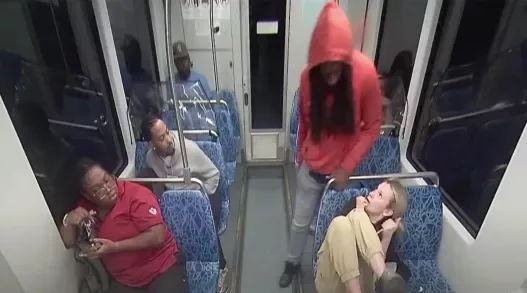The tragic stabbing of Iryna Zarutska on a Charlotte train has sparked intense discussions about the actions of bystanders during the incident. While it’s easy to criticize those who witnessed the event and did not intervene, a closer examination of the situation reveals a more nuanced perspective that encourages understanding rather than judgment.
In the aftermath of the incident, various angles of the video footage have circulated, providing insights into the chaotic environment of the train. These clips showcase not only the alarming nature of the attack but also the immediate reactions of those present. It’s crucial to recognize that in high-stress situations like this, individuals often react in unpredictable ways. Fear, shock, and uncertainty can paralyze even the most well-intentioned bystanders.
The first angle of the video shows the initial moments of the attack, where the assailant’s sudden aggression leaves little room for a measured response. Many bystanders appear frozen, their expressions a mix of disbelief and horror. In such a fast-paced and frightening scenario, it’s understandable that some might choose to prioritize their own safety over intervening. The instinct to protect oneself is deeply ingrained and can override the desire to help others.
The second angle presents a broader view of the train car, highlighting the cramped conditions and the presence of numerous passengers. With limited space and the potential for the situation to escalate further, the decision to intervene becomes even more complicated. Bystanders may have feared that stepping in could lead to additional violence, not just for themselves but for others in the vicinity. The reality is that intervening in a violent altercation is fraught with risks, and many people may not feel equipped to handle such a dangerous situation.
Moreover, societal expectations often place a heavy burden on individuals to act heroically in moments of crisis. However, the reality is that not everyone has the training or presence of mind to step in during an emergency. Many people may not know how to de-escalate a violent situation or may panic, rendering them ineffective in their attempts to help. It’s essential to acknowledge that while we may hope for courage in others, not everyone possesses the same level of confidence or capability in high-pressure situations.
Additionally, the psychological impact of witnessing violence cannot be underestimated. Bystanders may experience trauma from the event, which can lead to feelings of guilt or shame for not intervening. This emotional toll can linger long after the incident, affecting their mental well-being. Instead of casting blame, we should consider the complex human emotions that come into play during such distressing moments.
While it’s important to discuss the responsibilities of bystanders in emergency situations, we should also focus on creating a culture that encourages preparedness and support. Education on how to respond to violent incidents, including self-defense training and de-escalation techniques, can empower individuals to intervene safely. Community programs that foster dialogue about these issues can also help normalize discussions around intervention and support.
In conclusion, the stabbing incident on the Charlotte train serves as a stark reminder of the unpredictable nature of violence and the challenges faced by bystanders. Rather than judging those who witnessed the attack, we should strive to understand the complexities of human behavior in crisis situations. By fostering a more empathetic perspective and promoting education on emergency responses, we can create a society that is better equipped to handle such tragic events in the future.
